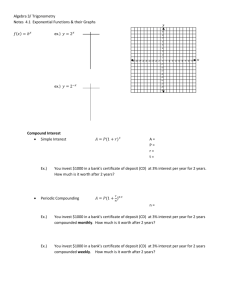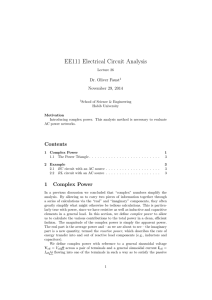Chapter 2 The Time Value of Money
advertisement
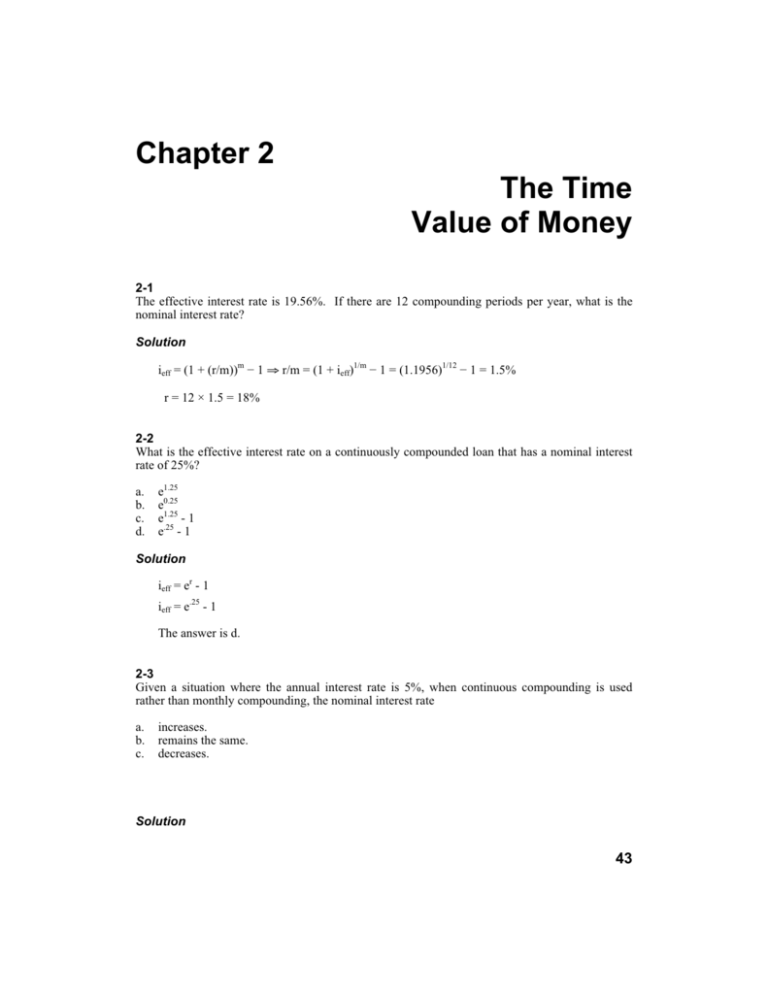
Chapter 2 The Time Value of Money 2-1 The effective interest rate is 19.56%. If there are 12 compounding periods per year, what is the nominal interest rate? Solution ieff = (1 + (r/m))m − 1 ⇒ r/m = (1 + ieff)1/m − 1 = (1.1956)1/12 − 1 = 1.5% r = 12 × 1.5 = 18% 2-2 What is the effective interest rate on a continuously compounded loan that has a nominal interest rate of 25%? a. b. c. d. e1.25 e0.25 e1.25 - 1 e.25 - 1 Solution ieff = er - 1 ieff = e.25 - 1 The answer is d. 2-3 Given a situation where the annual interest rate is 5%, when continuous compounding is used rather than monthly compounding, the nominal interest rate a. b. c. increases. remains the same. decreases. Solution 43 44 Chapter 2 Time Value of Money The answer is b: Remains the same 2-4 A local bank is advertising they pay savers 6% compounded monthly, yielding an effective annual rate of 6.168%. If $2,000 is placed in savings now and no withdrawals are made, how much interest (to the penny) will be earned in one year? Solution Interest = Effective annual rate × principal = 0.06168 × 2,000 = $123.36 Monthly compounding is irrelevant when the effective rate is known. 2-5 A man decides to put $100 per month beginning one month from today into an account paying 12% compounded monthly. Determine how much (to the nearest penny) will be in the account immediately after the fourth deposit using only basic concepts. Solution Month 1 2 3 4 Beginning Balance $ 0.00 100.00 201.00 303.01 Interest @ 1% 0.00 1.00 2.01 3.03 Deposit $100 100 100 100 Ending Balance $100.00 201.00 303.01 406.04 ←Answer 2-6 A small company borrowed $10,000 to expand the business. The entire principal of $10,000 will be repaid in 2 years but quarterly interest of $330 must be paid every three months. What nominal annual interest rate is the company paying? Solution The $330 is interest for one period, therefore i = 330/10,000 = 3.3% per quarter r = 3.3 × 4 = 13.2% nominal annual 2-7 A Cole’s Home Solutions policy is to charge 1¼% interest each month on the unpaid balance. What is the nominal interest the Cole’s is charging? What is the effective interest? Solution (a) r = mi = 12(1.25) = 15% (b) ieff = (1 + i)n - 1 = (1.0125)12 - 1 = 16.075% Chapter 2 Time Value of Money 45 2-8 E. Z. Marc received a loan of $50 from the S.H. Ark Loan Company that he had to repay one month later with a single payment of $60. What was the nominal annual interest rate for this loan? Solution Interest = $10 for one month i = 10/50 = 20% i = im = 20 × 12 = 240% 2-9 A local college parking enforcement bureau issues parking tickets which must be paid within one week. The person receiving the ticket may pay either $5 immediately or $7 if payment is deferred one week. What nominal interest rate is implied in the arrangement? Solution i = (7 - 5)/5 = 40% per week r = im = 52(40) = 2,080% 2-10 A deposit of $300 was made one year ago into an account paying monthly interest. If the account now has $320.52, what was the effective annual interest rate? Give answer to 1/100 of a percent. Solution ieff = 20.52/300 = 6.84% 2-11 Which is the better investment, a fund that pays 15% compounded annually, or one that pays 14% compounded continuously? Solution ieff = 15% compounded annually = [(1 + .15)1 - 1] = 15% ieff = 14% compounded continuously = [e.14 - 1] = 15.03% Therefore 14% compounded continuously is slightly better. 2-12 Ten years ago, Jenna C. deposited $2,000 into an account that paid 5% simple interest for the first four years and then it paid 6% compounded monthly for the remaining six years. The amount in the account at the end of the ten-year period is closest to a. b. c. d. $3,420 $3,440 $3,460 $3,480 46 Chapter 2 Time Value of Money Solution Simple interest earned at end of four years = 2,000 × .05 × 4 = $400 i = 6/12 = ½% n = (12)(6) = 72 F = 2,400(1.005)72 = $3,436.90 The answer is b. 2-13 You borrowed $25 from a friend and after five months repaid $27. What nominal interest rate did you pay? What was the effective interest rate? Solution F = P(1 + i)n 27 = 25(1 + i)5 (27/25)1/5 = 1 + i = 1.0155 i = 1.55% per month or 18.6% per year ieff = (1 + .0155)12 - 1 = 20.27% 2-14 A local Qwik Kash will loan a person $2,000 with a payment of $2,200 due in four weeks. What nominal annual interest rate is the company is charging? Solution i = 200/2,000 = 10% r = 13 × 10% = 130% 2-15 The effective interest rate on a mortgage with monthly payments is 9.38%. What is the monthly interest rate on the mortgage? What is the nominal interest rate? Solution ieff = [(1 + i)m - 1 ] = 9.38% .0938 = [(1 + i)12 - 1] 1.0938 = (1 + i)12 i = .75% (per month) r = im = .75 × 12 = 9% Chapter 2 Time Value of Money 47 2-16 One thousand dollars is deposited into an account that pays interest monthly and allowed to remain in the account for three years. The balance at the end of the three years is $1,309.00. The nominal interest paid on this account is nearest to a. b. c. d. ¾% 9% 9.38% 10.3% Solution F = P(1+ i)n 1,309 = 1,000(1 + i)36 1.309 = (1 + i)36 i = .75% (per month) r = im =.75 × 12 = 9% The answer is b. 2-17 John Buck opens a savings account by depositing $1,000. The account pays 6% simple interest. After three years John deposits another $2,000. The amount in the account when John withdraws the money eight years after the first deposit is nearest to a. b. c. d. $3,180 $4,080 $4,270 $4,520 Solution F with simple interest = P + P(i)(n) F = 1,000 + 1,000(.06)(8) ← Initial deposit remains in the account for the full eight years + 2,000 + 2,000(.06)(5) ← Second deposit remains in the account for five years F = $4,080 The answer is b. 2-18 Money invested at 6%, compounded monthly will triple in approximately how many months? a. b. c. 19 57 113 48 d. Chapter 2 Time Value of Money 221 Solution i = 6/12 = ½% Let F = 3 and P = 1 F = P(1 + i)n 3 = 1(1 + .005)n 3 = 1.005n n= = 220.27 The answer is d. 2-19 A grandfather gave his grandchild $100 for his 10th birthday. The child’s parents talked him into putting this gift into a bank account so that when he had grandchildren of his own he could give them similar gifts. The child lets this account grow for 50 years, and it has $100000. What was the interest rate of the account? (a) 15.0% (b) 15.8% (c) 14.8% (d) 14.0% Solution $100,000 = $100(1 + i)50 i = 14.8% The answer is c.
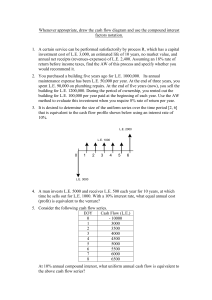
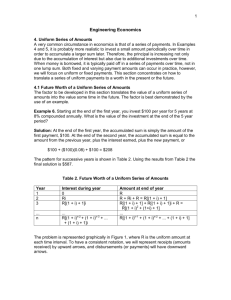
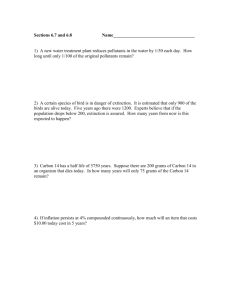
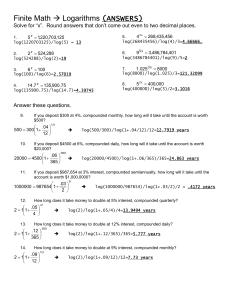
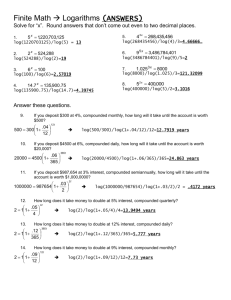

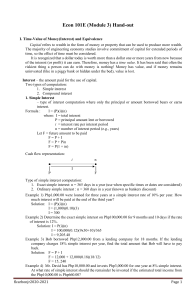
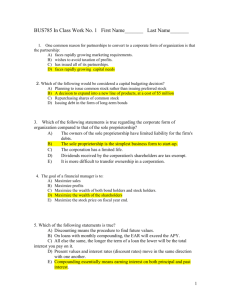
![Practice Quiz Compound Interest [with answers]](http://s3.studylib.net/store/data/008331665_1-e5f9ad7c540d78db3115f167e25be91a-300x300.png)
